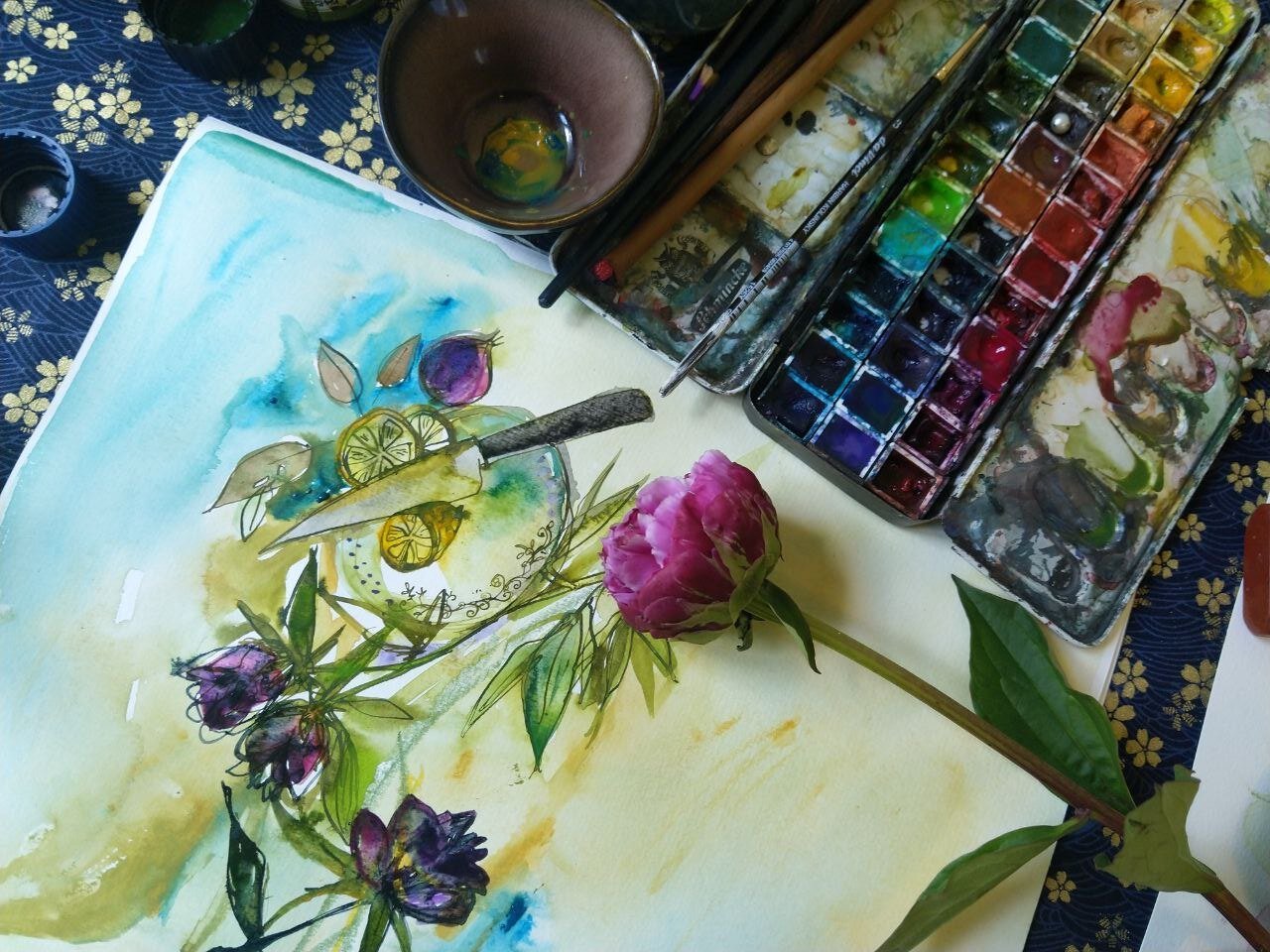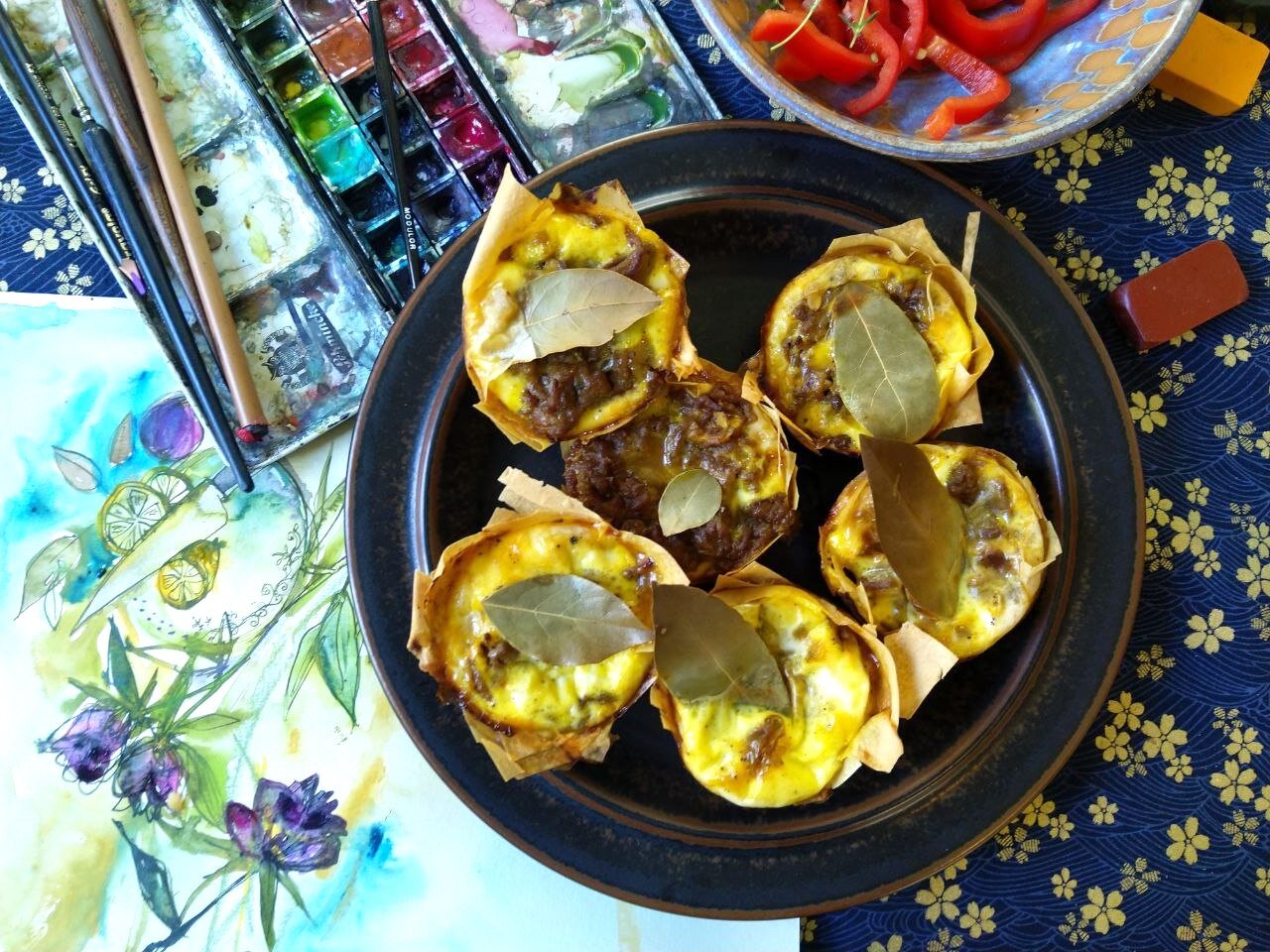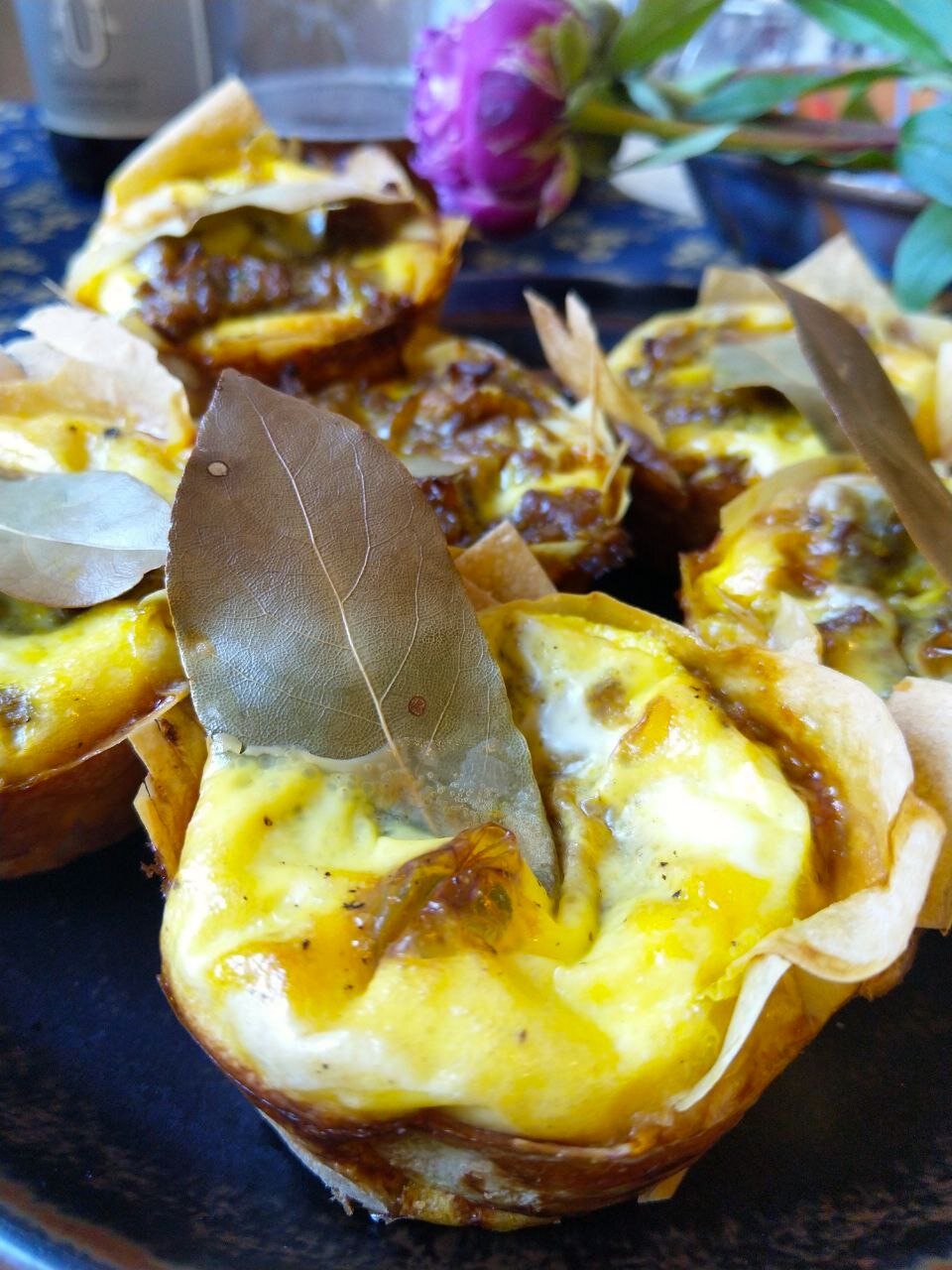
blog
Welcome to my blog. This is a place where I think out loud, show you what I’m up to in the studio, share impressions of inspiring events or everyday moments that moved me. Some entries are carefully curated essays, others are just a few thoughts, sometimes written in English and sometimes in German.
Featured posts

newest blog entries:
Sunday Lunch Blues: Miniature Bobotie Parcels
Turmeric is a very potent pigment for painting, as well as a delicious and healthy way to spice up food.
In a fit of nostalgia and longing for some place unknown that might be the idea of home, I decided to make miniature Boboties - a traditional South African recipe that exists in a thousand different varieties. Here is my version, tucked into small phyllo pastry parcels. Perfect for small one-person portions, or finger-food at a tapas buffet.
I had tremendous fun not only making the food, but taking time to prepare ingredients and create a watercolour drawing or two on the side.
Here is a list of ingredients you will need, enough for a four-person Bobotie or plenty for a whole muffin pan. If you have any of the mixture left over, freeze it for future use.
500g mince meat (ideally a mixture of lamb and beef if you can get it)
25ml olive oil & a spoonful of butter, plus some to grease the pan
2 white & 1 red onion
2 crushed & chopped garlic cloves
a teaspoon of chopped fresh ginger
1 small grated apple
3 teaspoons of apricot jam
a slice of brown bread soaked in 125 ml beef stock
3 teaspoons curry powder
1 teaspoon turmeric
1/2 teaspoon cumin powder
1/2 teaspoon coriander pwder
salt, pepper & lemon juice to taste
phyllo pastry
250 ml milk
three large eggs
bay leaves or lime leaves to decorate
Magical colour combination.
This small bowl is made by my grandmother, Konstanze Harms, whom I had an exhibition with last year in South Africa.
First, fry the mince in a little butter and olive oil. Remove from pan.
Then chop and fry the onions, add the garlic and ginger.
Preheat oven to 180 degrees Celsius.
That smell….
Add the meat to the onion mixture, then the spices (turmeric, curry, coriander, and cumin). Grate the apple and sprinkle with lemon juice. Add that to the mixture too.
Sometimes I use whole coriander seeds as well as ground coriander - because I love the flavour so much.
Add apricot jam, and the soaked (and broken into bits) slice of bread. Finish with salt and pepper. Let everything simmer for a bit.
Traditional recipes call for raisins as well, but honestly, I hate them. Up to you!
Grease the muffin pan and layer phyllo pastry (cut into small squares with your kitchen scissors) into the individual moulds. Three to four layers of phyllo pastry are ideal. Alternatively, grease one large casserole dish.
Spoon the meat mixture into the pastry shells.
Now, for the topping, mix the eggs and the milk with a fork. Add a lot of pepper, and a little salt.
Spoon this mixture over the Bobotie parcels to create a smooth eggy layer on top. Decorate with bay leaves.
Bake in hot oven for anything between 25 and 45 minutes, depending on the size of your casserole dish or muffin pan.
Meanwhile, open a craft beer or a crisp chardonnay. Sit down and contemplate things. Do some watercolour drawing. Check your Instagram for nothing in particular. Check the oven to see whether your miniature Boboties are browning on top yet, the egg becoming all fluffy and puffed-up. Do some more drawing. Maybe, make a salad or some tomato salsa.
Bobotie is traditionally served with rice, chutney, grated coconut and sliced banana, sometimes with a finely chopped tomato and onion salad. But you don’t have to do that at all if you don’t feel like it - get creative, these are compatible with so many side dishes.
And there you go.
Enjoy! Lovely to share, and lovely to eat on your own.
Ta-daaaaa!
Spatter. Summer earrings. Enamel on sterling silver, reconstituted carved coral, freshwater pearls.
The Power of Selective Storytelling: Avoiding the Dark
An evening view at “the lower dam” in late August.
Grandfather, being all grandfatherly. Slanted evening sunlight.
After the winter rains, the dams are (hopefully) all filled to the brim. My garndparents’ dog, Titania, splashing through waterblommetjies.
The worst was the smell, and the unidentifiable, chunky slime.
I have this profound childhood memory of walking with my grandfather on the farm, when we found an ewe lying on the ground, on one of those broad granite boulders surfacing from the grass. It was almost evening. She was groaning and struggling, clearly in labour and in considerable pain. My grandfather knelt down to examine her and I tried to calm the poor animal by holding her head and covering her eyes. I must have been about ten years old, maybe a bit younger.
We found that she was battling to give birth to twins, both of them dead. The first one, gently freed by my grandfather, had cream-coloured short wool and was covered in a thin, bloody film, and it looked like it was asleep. I remember that face, scrunched up but perfect in its smallness. The second lamb had been dead for longer, it was half decayed already and came apart in my grandfather’s hands. The smell was horrible. I remember thinking that the least I could do to honour this creature’s suffering, was to endure the nauseating smell unflinchingly. I remember how black the blood looked, lumpy bits of bloody tissue and pale limbs wrapped in slime. And I remember feeling a great sadness for something that could never be, never become.
That must have been the first significant encounter with the gruesomeness of death in my life, although I had seen dead and dying animals before – pets that had died or been run over by cars, and slaughtered animals of course – and the concept of death, animal and human, had always been part of my world in stories, as far as I can think back. But this was different. I was filled with a kind of awe at the power of life and death and their cycles. I intuitively understood, perhaps at that very moment, that life will give and take, that resistance is a waste of energy, and that one way of finding contentment is to surrender to this power and willingly accept its gifts and bear its losses with a kind of earnest grace. I have been able to deal with loss in my life so far, experiencing a type of unhurried grief while knowing that it must be part of the human experience.
The stories I have been telling about the farm I grew up on, specifically in light of our upcoming exhibition there, are stories of springtime and wildflowers, of imaginative childhood games, running barefoot, more summer fruit than anyone could ever stomach, stories of grape harvests and eating watermelon and horse-riding and achingly beautiful landscapes. “What an idyllic childhood you must have had!” people say to me, sometimes with an accusing undertone in their voices.
Jim, a bit of a whirlwind at times.
But it isn’t the only truth. Sometimes I tend to display the brightest of memories like polished pebbles in a row. We are all sentimental beings. Perhaps it’s true that I am guilty of hiding dark moments in dark imaginary closets. I have been thinking about this lately, and I am most certainly guilty of selective storytelling, illuminating the positive aspects of a narrative to gather strength and positive energy. And perhaps I’m guilty of accidentally ignoring darker aspects in an attempt to stay optimistic and joyful. Maybe there are emotions I am not yet able to articulate, but I think I should try. It’s also true that I often don’t judge experiences as “good” or “bad” immediately; I simply try to live them, which isn’t an easy notion to convey in a world that constantly judges and pressures to be better and shinier every day.
I want to try and be more mindful of all kinds of events and viewpoints in my storytelling. Stories are nothing but fragments, chained together by time, often in archetypal patterns that move us precisely because they are timeless and universal. In my mind, there is no such thing as “the whole story” or “the only correct version” of a story, but I want to be more articulate, delve deeper and explore darker fragments and memories that may be painful to write and read about, alongside the bright stories that buoy us up.
My childhood wasn’t idyllic. It wasn’t bad either. It was my reality. It was rich and filled with creativity and inquisitiveness and meaning. I was fascinated with all kinds of bizarre experiences. There were nasty thorns on that farm, and our feet had to be de-thorned with a needle on an almost bi-weekly basis by my patient mother. That never stopped us from running around barefoot. That feeling of lightness and freedom outweighed the short stab of pain caused by a thorn. Besides, our feet grew callous and immune to thorns eventually.
Woven into that story of a childhood on a wine farm near Cape Town are complex stories of my heritage. Stories of wars and hiding in bomb shelters and life in WWII Germany that were never really talked about in our family. Stories of growing up in Soviet Hungary, yearning for personal freedom, stories littered with rejection and judgement and regret and pain and helplessness. Stories of experiencing reality on the easy side of Apartheid. And in between, chicken running across a yard strewn with purple Jacaranda blossoms, and us hunting guinea fowl as they flock home to their sleeping trees by the hundreds, pretending to be Indian warriors, and climbing trees to the very top. It’s really a thick, complicated narrative with thousands of threads, our grandparents’ fears suddenly bearing their teeth and ancient societal norms resurfacing from god knows where. I hope to delve into this narrative in a more articulate way as I get older and more capable of untangling and reframing these images with my personal lens. I hope to show the darkness and the callousness and the scars interlaced with new life and light and relentless love. And above all, I wish to show that each individual carries a meaningful web of stories inside, like a glowing gem.
More waterblommetjies, a whole pond. These are edible and make a delicious traditional Cape lamb stew ingredient.
Walking down to a grassy part at the lower end of the farm.
An Ode to Multidentities
I was nervous about that visit: I barely have an inkling of the emotional power that landscape can wield, but it’s enough to recognize that landscape is etched into our souls, that a mountain or an ocean can cry out to you and make you scatter all rationality to the winds, until you forget your very valid reasons for leaving that mountain, that sea, the very earth that brought you forth, even if they are reasons your very existence may depend upon.
Vineyards around Stellenbosch. Mountains, to me, have to be purple to be “real” mountains.
Originally written in April 2018.
As I’ve just returned from a six-week stay in South Africa, I am taking some time to digest my experiences and pick apart some my feelings about countries and identities.
South Africa to me is that exquisite country, the place I hail from and that shaped my personality, but not really my (only) home anymore.
Some time ago I uprooted my life there, packed it into a couple of suitcases, and let myself be blown up into the sky like a feather giving itself up to the wind. I touched ground again in Berlin, where I have begun to lay the foundations of a second home since January 2017. Now I have visited South Africa for the first time again after I left, revisited my past, sifted through old fear and pain and joy and broken love and adolescent shame and tokens of friendships. I was nervous about that visit: I barely have an inkling of the emotional power that landscape can wield, but it’s enough to recognize that landscape is etched into our souls, that a mountain or an ocean can cry out to you and make you scatter all rationality to the winds, until you forget your very valid reasons for leaving that mountain, that sea, the very earth that brought you forth, even if they are reasons your very existence may depend upon. So I was scared of that.
But I needn’t have been. This visit strengthened me in my dual identity and allowed me to articulate both my desire to really live that richness of a fragmented identity, and my inability to be only one thing. It’s true, I feel more of a South African now that I return to Berlin than I felt the whole of last year. But I am not an expat, I feel just as much German, with an added foreign tinge that is something else all together. For the first time, I feel liberated from that strange obligation of having to choose only one identity.
Even the way I speak is a testament to that: over the years, I have developed this unique accent when speaking English, distinctly European in my pronunciation, with a sing-song melody to my sentences, an unusual rhythm of sorts, and a rather large vocabulary for someone who was raised in another language, I’d like to think. At first, this accent bothered me a lot. Now I think it’s a wonderful fusion that bears witness to my life so far, and I wouldn’t want to lose it for the world.
What I have learned more and more over the past years is to make my work – my art – my true home. What I am attempting in my work is much larger than I am, larger than my life, an imaginary empire, a vast paradise garden, something that will remain after my body has become dust. I am tapping into a collection of ancient stories that have been the same since the birth of culture and will be the same until sapiens is extinct from the universe. And if I manage to remind a few people why life is worth living, my time here has been worthwhile.
So during this visit to South Africa I attempted to collect fragments of imagery, little pollen-sacks of memories, to be carried home – that other imagined home in my work – to become part of the layered visual language I am developing there. I’m taking those moments with me that will enrich and inspire my life, for now, and choosing to leave those things behind that burden and stress me unnecessarily. Perhaps there will be more writing about the dark side of life in South Africa at a later stage.
Into my imaginary suitcase I packed that rich diversity of the Cape Fynbos, intriguing with its inconceivably delicate structures contrasted with strong lines and hard scratchy stalks. Small bunches of bells that beckon the curious soul, the tiniest flowers, so indifferent and so lavishly scattered across the mountains. Thousands of furry leaves, soft as a Labrador’s ears, with red serrated tips. Dew drops in neat rows, glinting like diamonds and on some level infinitely more valuable because of their transient existence. Burned protea stalks silhouetted against bright yellow-green and rusty reds.
I’m taking with me that primordial taste of the ocean, the salty flavour of the womb of the world – exciting and comforting at once, with a wildness to it that envelops your whole body when you submerge yourself in it, inside and out. And that staggering rhythmic force of the waves rolling and tossing and pushing and pulling to remind myself that I am quite small, quite insignificant in this large world.
I’m packing the slow creeping of autumn in the vineyards around Stellenbosch, the place where I spent some of the most formative years of my childhood. That exquisite colour combination of burning reds bleeding into lime greens, of golden-ochre paling into blotchy browns. These colours act like a trigger with me; they cause some inexplicable sensation deep within me, a tearing, beautiful, aching kind of pleasure. Every single time, without fail.
I’m taking the purple ring of mountains, that protective embrace of the Gods, enclosing the Cape of Good Hope. The way the setting sun tints the rocks pink and violet, the Hour of the Mountains, the most precious moment of the day when Time holds its breath and a minute is longer than sixty seconds.
All of these treasures I packed, and many more, laughter and friendship, turreted castles made out of clouds, wholesome ancient foods, apples directly from the tree and grapes from the vineyard, wine that tastes like a song, sweat and salty wind in my hair.
And I want to merge these treasures with my daily urban encounters here in Berlin, treasures that are very different but equally precious in their own way. Keep an eye out for a new summer collection inspired by all these sentimental wanderings (with too many adjectives in every sentence).
The empty Theewaterskloof Dam in March 2018, and little hope of more rain this winter.
































This summer, I have taken some time for deep thought to reflect on my most important beliefs underpinning my creative practice. I think of these nine concepts below as directional pointers for my inner creative compass. This is a deeply personal navigational tool for whenever the weather gets a little rough and stormy, and clear vision is impaired.